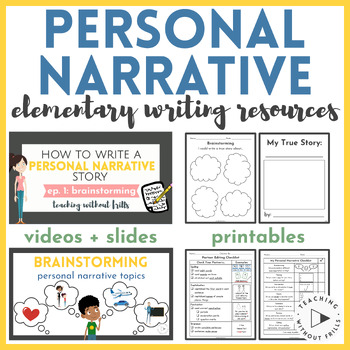Personal Narrative Story Writing Resources, Paper, Videos, Organizers, & Slides
- PDF
- Google Apps™

What educators are saying
Also included in
- This bundle includes all of the K-5 elementary writer's workshop resources I've made to accompany the videos on my Teaching Without Frills YouTube channel here: http://www.youtube.com/c/teachingwithoutfrillsI'm currently in the process of updating many of the products to include new videos, slides,Price $45.85Original Price $65.50Save $19.65
Description
If you're looking for a simple yet meaningful way to teach your elementary students to write a personal narrative, you've come to the right place!
This resource includes:
•8 Animated Videos embedded in Google Slides*
•62 Google Slides to use in lessons or print for anchor charts
•K-5 Writing Progression Charts (teacher information)
•Pre-Assessment & Post-Assessment (2 options)
•Brainstorming Graphic Organizers (4 options)
•Planning Templates (4 options)
•Story Covers (8 options)
•Blank Writing Paper (10 options)
•Editing Checklist
•Partner Editing Checklist
•Personal Narrative Student Checklist
*The included videos are updated versions of my old writing videos you may have seen on YouTube! In this resource, you will have exclusive access to the new versions, embedded into a Google Slides document from my unlisted YouTube page. You can stream all of the updated videos ad-free, but will not be able to download the video files.
How To Use
•This resource supports a Writer’s Workshop structure, in which a teacher models a specific teaching point or strategy during a short mini-lesson (5-10 minutes), students write independently (20-30 minutes), and then meet back together to review and share (5-10 minutes).
•The wonderful thing about Writer’s Workshop is that students can work at their own pace and level. I’ve provided different paper choices so you can best support the needs of your students. I always print out plenty of copies of each level and let students choose their own.
•It may be helpful to have students keep their “Work in Progress” in a writing folder, and then assemble their books with staples at the end of the unit. This way, students can make their own choices about paper used, the length of their book, and how they revise by adding, changes, or rearranging pages.
•When students finish a book early, I usually give 2 options: Add more pages to your book or start a new one. When it is time to revise and edit, they can choose their favorite to publish. :)






